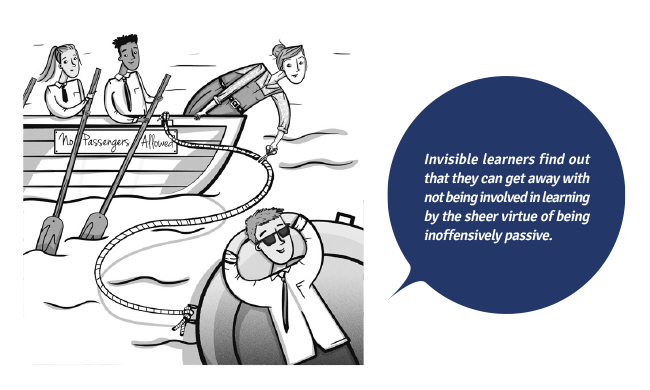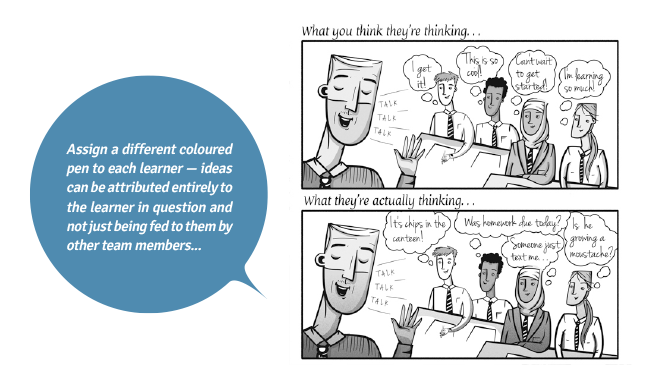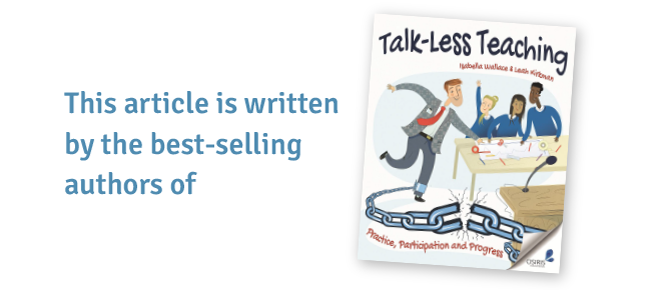Osiris trainers, Isabella Wallace and Leah Kirkman, share an exclusive extract from their practical and engaging new book ‘Talk-Less Teaching’.
With the best will in the world, it is difficult to avoid teaching to the loudest learners in our class. Sometimes they are literally loud because they are a serial disturber of the peace – with their voice as the nefarious weapon. Sometimes they are physically loud because they fidget, fuss, turn around and move about the classroom uninvited. Even when they are purposefully loud – consistently providing ideas, responses and thoughts to the questions you raise – they belong to the category of learners who can dominate our attention, both positively and negatively. The progress that these learners are making (or not making) is quite clear to us over the course of a lesson.
The learners who require more astute observation are the invisible learners: the ones who come into our lessons, cause no fuss or conflict, and are skilled at coasting under our radars, eclipsed by the huge range of loud peers around them. Not out of any malice or trickery, these invisible learners are able to avoid the confrontation of being accountable for their participation in lessons by being manifestly compliant – their exercise books are out, their pens are poised and eye contact is being made – so you are unaware they have made little or no progress until you have taken the books in and the misunderstandings and/or lack of productive work becomes all too visible. Although this can be acted upon and rectified retrospectively, in many ways it is already too late.
The under-performance of invisible learners due to their lack of engagement is just as concerning as the lack of progress from learners who prevent their own advancement through disruption: it is an undesirable learning behaviour that prevents them from making gains in their knowledge, skills and understanding. One way that we can combat this, and ensure that these learners make good progress and do not opt out of their learning, is to plan activities that ‘force’ participation from all. Planning activities that make non-participation obvious means that it is much easier to spot the struggling learner, offer them support and draw them into activities before they have a chance to fall behind.
The other advantage of using strategies that force participation is that the progress in your lesson becomes highly visible. This is obviously desirable for the class teacher – who can then react and respond to the learning accordingly. But the class teacher is not the only stakeholder for progress in the classroom.
Ensuring that progress is visible to the learners in the class, and flagging this up, is motivating and empowering for those at the crux of the learning. Though the gains, certainly over just one lesson or even a portion of a lesson, may be small, spotting them and celebrating them is a sure-fire way to ensure that the class remain keen to continue moving forward. Failing to see the point of a learning activity is the quickest way to switch learners off, especially the more reluctant learners in the group. By demonstrating to them the gains that are being made in the short term, the purpose of their learning will be much clearer.
Consider some of the following practical strategies as ways to eliminate the ‘passengers’ in your lessons and build the ethos of active participation.

The Vertical Relay (The Only Way Is Up!)
The Vertical Relay is a collaborative exercise where learners work together as a team to complete a task with in built levels of increasing challenge. The class is divided into teams and a stimulus (ideally produced on a large piece of paper) is provided to each team. This can be pinned up around the walls of the room or, if wall space is scarce, simply placed in the centre of a group of tables. Each member of the team, in turn, contributes to the group task before passing on the ‘baton’ (in this case, a pen) and then joining the back of the queue again. You’ll find that a lot of peer teaching occurs as learners confer with and support each other throughout the process, ensuring that each member of the team is contributing to the end product.
To track individual contributions and ensure that all team members are participating, assign a different-coloured pen to each learner. To ensure that the ideas can be attributed entirely to the learner in question – and are not just being fed to them by other team members – you can always run a ‘silent relay’ where learners can only encourage each other through body language and facial expressions.
The ‘vertical’ part of the relay is ensuring that there are varying levels of challenge available in completing the task, and providing higher points values to higher-level responses. In this way, no learner is capped and everyone can attempt to gain the greatest number of points for their team by pushing themselves to the next level of challenge.
Another excellent way to get learners to take in others’ ideas is to allow a timed ‘magpie’, where they get a short burst of time (e.g. 30 or 60 seconds) to go around the class and ‘steal’ any ideas they had not thought of to record on their own sheets. Although the students feel like this is a deliciously sneaky cheat and an exciting way to rack up points, they are, in fact, simply picking up best practice from their peers and expanding their own understanding.
You can use the Vertical Relay to establish a baseline with your class. It’s a quick and highly visible way to verify what your learners know at the outset of a lesson. You can also use this strategy as a way to check progress at intervals throughout the lesson as the teams add to, or correct, their initial responses.

Crash! Bang! Wallop!
This strategy is another highly visible way to establish, in a short period of time, your learners’ understanding of a given concept. As with Vertical Relay, you can use this to quickly ascertain the starting points of your class, and as a means to assess progress against the learning objective. It is an easy way to assess the impact of your teaching so that you know whether learners are ready to move on to the next stage of the lesson.
Crash! Bang! Wallop! involves learners providing a physical signal when they can recognise an aspect of their learning aurally or visually. For example, in a maths lesson where you wish to teach (or perhaps remind) the class about the 8 times table, display a 1–100 square on the board and begin counting together as a class. When counting, learners must provide a physical signal, such as putting up their hand or bending their knees (if they are standing) when they see and/or hear a number that they know is a multiple of 8 – thus showing that they have recognised it.
As a baseline-setting activity, there can be no clearer way for you, or your class, to illustrate that they require some input on their 8 times table than seeing their classmates bobbing or waving out of unison. Repeat the exercise after some input and practice and, if apt progress has been made, you and the learners will see the chosen physical signal happening in harmony. In the event that there are still some in the class who are a bit woolly on the concept, you will quickly be able to spot them and offer appropriate support and intervention. Of course, it is likely that there will be some learners who are unsure about the concept and start off by watching what their classmates are doing. However, take heart, because as these nervous learners observe and copy their classmates, they will undoubtedly amass new understanding.
You can increase the challenge of the activity by providing more than one feature for learners to ‘spot’. In the numeracy example above, you may also wish to have learners looking for multiples of another number – for example, they should bend their knees when they see and hear a multiple of 8 and put their hand up when they hear a multiple of 6.
Not only will you get immediate, visible feedback about whether your class has successfully grasped the concept you’ve been teaching them, and about whether it’s safe to move on, but you will also be able to identify misconceptions on the spot. SR
Talk-Less Teaching by Isabella Wallace and Leah Kirkman
Teacher-talk is a powerful tool. But whilst we must embrace teacher-talk as vital, we must also bear in mind that not all teacher-talk is created equally…
The solution is here: a vast bank of exciting, engaging, practical ways to allow learners to access and understand complex topics and skills without relentlessly bending their ears. Strategies which not only prevent pupils from being passengers in lessons, but which also make progress visible to both teacher and learner.
In an entertaining and practical way, Talk-Less Teaching shows you how to encourage learners responsibility for their own progress without compromising test results or overall achievement. Discover hundreds of tried and tested practical tips for helping pupils understand difficult concepts and learn new skills without you developing lecture-laryngitis.
Get your copy at bit.ly/TLTbook



